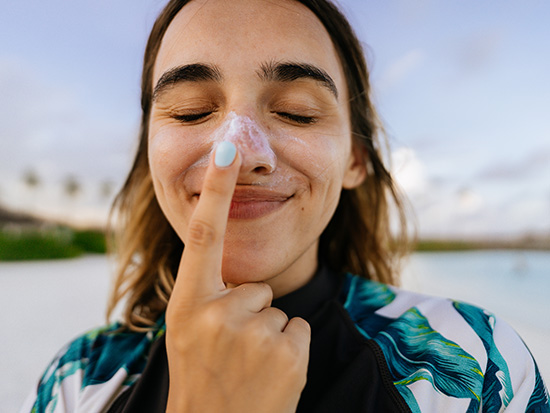Say no to sunburns, say yes to sunscreen
Written by: Hannah Echols
Media contact: Anna Jones

Schools are out, and summer fun has begun. Between pool days and beach trips, people are outside enjoying nature and soaking in the bright summer sun. While spending time outside has positive health benefits, the sun can be a short- and long-term enemy.
One in five Americans will develop skin cancer, according to estimates by the American Academy of Dermatology. Avoiding ultraviolet light — a risk factor for all types of skin cancer — could prevent more than 3 million skin cancer cases annually.
However, it is not always easy to avoid these harmful rays, especially during summer months, which is why using sunscreen is important. Lauren Kole, M.D., assistant professor in the University of Alabama at Birmingham Department of Dermatology, shares her best practices for sunscreen use.
What to buy
When picking out sunscreen, Kole suggests, start by looking at the sun protection factor. The AAD recommends using a 30 SPF or higher. No sunscreen can block 100 percent of the UV rays, but 30 SPF blocks around 97 percent. It is also recommended to look for a broad-spectrum sunscreen. These sunscreens help protect against both UVA rays, which cause premature aging in the skin, and UVB rays, which cause sunburn. Additionally, exposure to both UVA and UVB may lead to skin cancers in the future. Since most outdoor activities include sweating and/or getting in water, it is useful to look for water-resistant formulas as well.
Most sunscreen comes in one of four basic forms — spray, cream, gel or stick, and each type has its own application benefits consumers should consider.
- Spraysare currently the most popular type due to the ease of application; but people rarely apply enough, applying only around 25-50 percent of the recommended amount needed. Additionally, sprays are harder to control around the face, making it harder to prevent inhaling or ingesting the sunscreen, which can be harmful to the user.
- Creamsmay take longer to apply but can be applied to almost everywhere on one’s body, including the face. People tend to rub in and apply creams slightly more than they do when applying spray sunscreen.
- Sticksare not realistic to use for one’s entire body but are perfect for safely applying sunscreen to the facial area, including the lips. Many facial sunscreens also include moisturizing agents and other antiaging ingredients such as antioxidants.
- Gelsare not as common as sprays and creams but prove to be the most effective around hairy areas. For people who are not wearing a hat or head covering, gel sunscreen is a good option to help protect the scalp. Kole adds that powder sunscreens are also becoming more common and are a great option to use on one’s hair part.
Kole emphasizes the importance of checking to make sure a sunscreen selection is FDA- approved. Two ingredients, zinc oxide and titanium dioxide, are proposed to be safe and effective for sunscreen use, while two others, aminobenzoic acid and trolamine salicylate, are not considered safe or effective for sunscreen use by the FDA. All sunscreens containers are required to show an expiration date. If there is no date, the product should be considered expired three years after purchase.
How to use it
A quality sunscreen cannot be fully effective if it is not correctly applied. Kole suggests applying sunscreen at least 15 minutes before going outside. This allows the sunscreen time to fully absorb into the skin and form its protective barrier. The national recommendation to reapply sunscreen is every two hours; also reapply after swimming or excessive sweating. Follow the sunscreen directions regarding how often to reapply.
For more summer safety tips, click the link below,
After-sun best practices
Areas one cannot see or reach are commonly missed spots. Have someone else help apply sunscreen to hard-to-reach areas like the upper back, or make sure those areas are covered.
Do not replace sunscreen with tanning oil or lotion. Most of these lotions will not have near the recommended SPF for maximum UV protection. Even when applied with sunscreen, some tanning oils and lotions can counteract the protective ingredients.
In addition to sunscreen, other sun-protection best practices include wearing coverings, such as hats, and sunglasses, and being extra diligent about applying sunscreen when in direct sunlight between 10 a.m. and 4 p.m.
Kole also notes that sunscreens are not recommended by the FDA for infants under 6 months. All children 6 months and older should wear protective clothing and sunscreen. Parents should aim to keep infants out of the sun during peak hours and speak with their pediatricians before applying sunscreen under 6 months of age.
After sun exposure, Kole suggests taking cool baths to reduce the heat, applying moisturizers and drinking plenty of water to prevent dehydration. Hydrocortisone cream may be applied to sunburns to ease discomfort.
People should also avoid using products ending in -cain, because it will not help the burn. These products only reduce pain and will not treat the underlying skin damage, and overuse of these products can have side effects.
With any sunburn, avoid the sun while skin heals, and be sure to cover the sunburn every time one heads outdoors.




